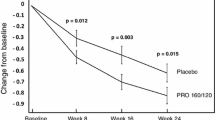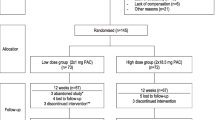Summary
In this review, results of randomized double-blind controlled clinical trials (RCTs) with extracts of Serenoa repens fruits at a dose of 320 mg/d for the treatment of lower urinary tract symptoms (LUTS) are assessed. Of the RTCs conducted for up to 6 months, a benefit was seen in three of three RTCs with ethanolic, in eight of nine RTCs with hexane, and in one of two RTCs with CO2 extracts. Of the RTCs conducted for more than 6 months, a benefit was seen in two RTCs with hexane and in one RTC with CO2 extracts, whereas one RTC with an ethanolic, two RTCs with hexane, and one RTC with CO2 extracts did not show positive results. As LUTS are dynamic conditions with strong spontaneous fluctuation over time, the majority of patients might expect improvement of single symptoms and thus of quality of life, particularly as the extracts are well tolerated even in long-term treatment.
Zusammenfassung
In dieser Übersicht werden die Ergebnisse randomisierter kontrollierter Doppelblindstudien mit Extrakten aus den Früchten der Sägepalme, Serenoa repens, in einer Dosierung von 320 mg/Tag bei Beschwerden des unteren Urogenitaltrakts („lower urinary tract symptoms“, LUTS) bewertet. Von den Studien mit einer Studiendauer von bis zu 6 Monaten zeigten 3 von 3 Studien mit ethanolischen, 8 von 9 Studien mit Hexan- und 1 von 2 Studien mit CO2-Extrakten eine Wirksamkeit. Von den Studien mit einer Dauer von mehr als 6 Monaten ergaben 2 Studien mit Hexanextrakten und 1 Studie mit CO2-Extrakten eine Wirksamkeit, während 1 Studie mit einem ethanolischen Extrakt, 2 Studien mit einem Hexanextrakt und 1 Studie mit einem CO2-Extrakt kein positives Ergebnis zeigten. Da Beschwerden des unteren Urogenitaltrakts dynamische Erkrankungen mit starken spontanen Fluktuationen über die Zeit sind, kann die Mehrzahl der Patienten eine Verbesserung von Einzelsymptomen und damit der Lebensqualität erwarten, zumal die Extrakte selbst bei Langzeitanwendung gut verträglich sind.
Similar content being viewed by others
Notes
Both, the AUA and IPSS use the identical scale of 0 to 35, with mild symptoms scored 1 to 8, medium 9 to 18, and severe ≥19.
Committee on Herbal Medicinal Products
References
Coyne KS, Sexton CC, Thompson CL, et al. The prevalence of lower urinary tract symptoms (LUTS) in the USA, the UK and Sweden: results from the Epidemiology of LUTS (EpiLUTS) study. BJU Int. 2009;104(3):352–60.
Rosenberg MT, Staskin DR, Kaplan SA, et al. A practical guide to the evaluation and treatment of male lower urinary tract symptoms in the primary care setting. Int J Clin Pract. 2007;61(9):1535–46.
AWMF-Leitlinie. Therapie des Benignen Prostatasyndroms der Qualität S2e – Therapy of benign prostate syndrome S23. Register Nr. 043/035. 2014.
Madersbacher S, Marszalek M. Benign prostate hyperplasia: success and limitations of pharmacological therapy. Internist (Berl). 2007;48(10):1157–64.
Oelke M, et al. Medikamentöse Therapie der benignen Prostatahyperplasie. Urologe. 2009;48:1365–77.
Wehrberger C, Dreikorn K, Schmitz-Drager BJ, et al. Phytotherapie bei benignem Prostatasydrom und Prostatakarzinom. (Phytotherapy of benign prostate syndrome and prostate cancer: better than placebo). Urologe. 2012;51(12):1674–82.
Mohanty NK, Jha H, Dutt C. Randomized double-blind controlled clinical trial of Serenoa repens versus placebo in the management of patients with symptomatic grade I to grade II benign prostatic hyperplasia (BPH). Indian J Urol. 1999;16:26–31.
Gerber GS, Kuznetsov D, Johnson BC, et al. Randomized, double-blind, placebo-controlled trial of saw palmetto in men with lower urinary tract symptoms. Urology. 2001;58:960–5.
Shi R, Xie Q, Gang X, et al. Effect of saw palmetto soft gel capsule on lower urinary tract symptoms associated with benign prostatic hyperplasia: a randomized trial in Shanghai, China. J Urol. 2008;179:610–5.
Mattei FM, Capone M, Acconcia A. Medikamentöse Therapie der benignen Prostatahyperplasie mit einem Extrakt der Sägeplame. TW Urol Nephrol. 1990;2:346–50.
Löbelenz J. Extractum Sabal fructus bei benigner Prostatahyperplasie (BPH). Therapeutikon. 1992;6(1–2):34–7.
Argirovic A, Argirovic D. Does the addition of Serenoa repens to tamsulosin improve its therapeutical efficacy in benign prostatic hyperplasia? Vojnosanit Pregl. 2013;70(12):1091–6.
Barry MJ, Meleth S, Lee JY, et al. Effect of increasing doses of saw palmetto extract on lower urinary tract symptoms: a randomized trial. JAMA. 2011;306(12):1344–51.
Braeckman J, Denis L, de Leval J, et al. A double-blind, placebo-controlled study of the plant extract Serenoa repens in the treatment of benign hyperplasia of the prostate. Eur J Clin Res. 1997;9:247–59.
Willetts KE, Clements MS, Champion S, et al. Serenoa repens extract for benign prostate hyperplasia: a randomized controlled trial. BJU Int. 2003;92:267–70.
Bent S, Kane C, Shinohara K, et al. Saw palmetto for benign prostatic hyperplasia. N Engl J Med. 2006;354(6):557–66.
Avins AL, Bent S, Staccone S, et al. A detailed safety assessment of a saw palmetto extract. Complement Ther Med. 2008;16:147–54.
Boccafoschi C, Annoscia S. Confronto fra estratto di Serenoa repens e placebo mediante prova clinical controllata in pazienti con adenomatosi prostatica. Urologia. 1983;50:1257–68.
Emili E, Lo Cigno M, Petrone U. Risultati clinici su un nuovo farmaco nella terapia dell’ipertrofia della prostata (Permixon). Urologia. 1983;50:1042–8.
Mandressi A, Tarallo U, Maggioni A, et al. Terapia medica dell’adenoma prostatico: Confronto della efficacia dell’estratto di Serenoa repens (Permixon) versus l’estratto di pigeum africanum e placebo. Urologia. 1983;50:752–7.
Champault G, Patel JC, Bonnard AM. A double-blind trial of an extract of the plant Serenoa repens in benign prostatic hyperplasia. Br J Clin Pharmacol. 1984;18(3):461–2.
Tasca A, Barulli M, Cavazzana A, et al. Trattamento della sintomatologia ostruttiva da adenoma prostatico con estratto di Serenoa repens. Minerva Urol Nefrol. 1985;37:87–91.
Reece Smith H, Memon A, Smart CJ, et al. The value of permixon in benign prostatic hypertrophy. Br J Urol. 1986;58:36–40.
Descotes JL, Rambeaud JJ, Deschaseaux P, et al. Placebo-controlled evaluation of the efficacy and tolerability of permixon in benign prostatic hyperplasia after exclusion of placebo responders. Clin Drug Investig. 1995;9(5):291–7.
Bauer HW, Casarosa C, Cosci M, et al. Sabalfrucht-Extrakt zur Behandlung der benignen Prostatahyperplasie. MMW Fortschr Med. 1999;141(25):62.
Stepanov VN, Siniakova LA, Sarrazin B, et al. Efficacy and tolerability of the lipidosterolic extract of Serenoa repens (Permixon) in benign prostatic hyperplasia: a double-blind comparison of two dosage regimens. Adv Ther. 1999;16(5):231–41.
Carraro JC, Raynaud JP, Koch G, et al. Comparison of phytotherapy (Permixon) with finasteride in the treatment of benign prostate hyperplasia: a randomized international study of 1,098 patients. Prostate. 1996;29:231–40.
Debruyne F, Koch G, Boyle P, et al. Comparaison d’un produit de phytothérapie (Permixon) et d’un alpha-bloquant (tamsulosine) dans le traitement de l’hypertrophie bénigne de la prostate: étude internationale randomisée d’une durée de 12 mois. Prog Urol. 2002;12:384–94.
Glemain P, Coulange C, Billebaud T, et al. Tamsulosine avec ou sans Serrenoa repens dans l’hypertrophie bénigne de la prostate: l’essai OCOS. Prog Urol. 2002;12:395–403.
Oelke M, Madersbacher S. Primary and secondary prevention of benign prostatic hyperplasia: current knowledge and implications for clinical management. Urologe. 2011;50(10):1257–64.
MacDonald R, Tacklind JW, Rutks I, et al. Serenoa repens monotherapy for benign prostatic hyperplasia (BPH): an updated Cochrane systematic review. BJU Int. 2012;109(12):1756–61.
Wang JY, Liu M, Zhang YG, et al. Relationship between lower urinary tract symptoms and objective measures of benign prostatic hyperplasia: a Chinese survey. Chin Med J. 2008;121(20):2042–5.
European Union herbal monograph on Serenoa repens (W. Bartram) Small, fructus, EMA/HMPC/280079/2013, Committee on Herbal Medicinal Products (HMPC), London, 24 November 2015, (2015).
Vaughan CP, Johnson TM 2nd, Haukka J, et al. The fluctuation of nocturia in men with lower urinary tract symptoms allocated to placebo during a 12-month randomized, controlled trial. J Urol. 2014;191(4):1040–4.
Pöyhönen A, Häkkinen JT, Koskimäki J, et al. Natural course of lower urinary tract symptoms in men not requiring treatment – a 5‑year longitudinal population-based study. Urology. 2014;83(2):411–5.
Nickel JC. Comparison of clinical trials with finasteride and dutasteride. Rev Urol. 2004;6(Suppl 9):S31–S39.
Avins AL, Lee JY, Meyers CM, et al. Safety and toxicity of saw palmetto in the CAMUS trial. J Urol. 2013;189(4):1415–20.
Aliaev Iu G, Vinarov AZ, Demidko Iu L, et al. The results of the 10-year study of efficacy and safety of Serenoa repens extract in patients at risk of progression of benign prostatic hyperplasia. Urologiia. 2013;4(4):32–6.
Acknowledgements
The authors thank Dr. Samuel Okpanyi, Wiesbaden, Germany, and Prof. Dr. Karin Kraft, Rostock, Germany, for discussions and proof reading.
Author information
Authors and Affiliations
Corresponding author
Ethics declarations
Conflict of Interest
All authors are members of the working group “Efficacy and Safety” of the Kooperation Phytopharmaka, GbR, Bonn, Germany. The paper was written in behalf of the working group and there was no competing financial interest.
Rights and permissions
About this article
Cite this article
Görne, R.C., Wegener, T., Kelber, O. et al. Randomized double-blind controlled clinical trials with herbal preparations of Serenoa repens fruits in treatment of lower urinary tract symptoms. Wien Med Wochenschr 167, 177–182 (2017). https://doi.org/10.1007/s10354-016-0526-2
Received:
Accepted:
Published:
Issue Date:
DOI: https://doi.org/10.1007/s10354-016-0526-2




